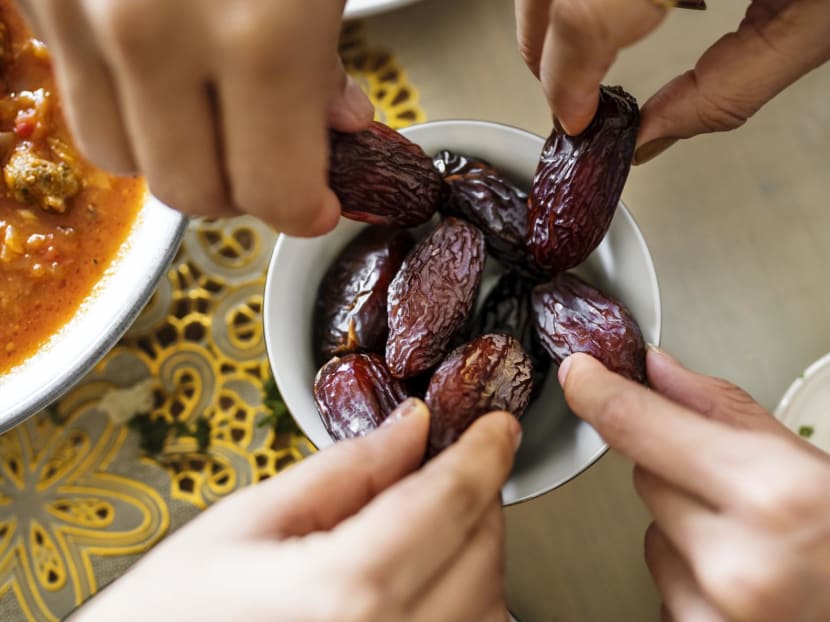All about dates: How nutritious are they as a snack and what’s the best way to enjoy them?
Whether you’re fasting or craving a snack, dates’ caramel-like flavour and jammy texture are a treat – and healthy, too.

(Photo: iStock/Rawpixel)

This audio is AI-generated.
If you fast during Ramadan, you’ll be familiar with dates. The dried fruit is often the first bite of food taken at iftar, the evening meal – and it is in honour of Prophet Muhammad, who is said to prefer breaking his fast with dates, that Muslims have this practice.
Many of us are familiar with the dried version but dates can actually be enjoyed in other stages of their development after harvesting. The main difference amongst them is their moisture content. For instance, the fresh, just-ripened date is known as khalal; it looks yellow and has an apple-like crunch, thanks to an 80 per cent moisture level.
The second rutab stage, at 50 to 70 per cent moisture, spots a partially browned tip that gradually spreads to the entire fruit. It is a state of deliciousness as that's when the date becomes soft and develops a caramel-like flavour. The firm, wrinkly tamr or tamar you usually find in supermarkets has just 10 per cent or less moisture.



Then, there are the various date varieties that have their own distinct characteristics. Deglet noor has a firm texture that lends well to baking and cooking while medjool is jam-like. But no matter the variety, dates can be enjoyed on its own, much like dried apricots or raisins, and consumers are spoilt for choice when it comes to options, especially if they wish to scrutinise suppliers of dates.
Got more date-ing questions? We’ve got some answers below:
CAN WE LET FRESH DATES DRY OUT ON THEIR OWN?
It's best not to, said Jaclyn Reutens, a clinical and sports dietitian with Aptima Nutrition & Sports Consultants. Fresh dates will go bad in Singapore’s humidity when left out in the open. To keep them for as long as six months, she recommends storing dates, both fresh and dried ones, in airtight containers and placing them in the refrigerator or freezer.
If you're keen to make dried dates, you can try with a dehydrator or an oven that is heated to a certain temperature for many hours. "But do not expect the same results as store-bought dried dates," said Reutens. “The dried dates we get from the supermarkets have been dehydrated according to food manufacturing standards.”
WHAT IS THAT WHITE SUBSTANCE WE SEE ON DATES?
It’s crystallised sugar, said Reutens, and it can appear on both fresh and dried versions. “As the dates age, the sugars in them gradually move to the surface and form white spots.” Dates to avoid are the ones that have a sour or fermented smell, and taste bitter, she said.

WHICH IS BETTER NUTRITIONALLY: DRIED OR FRESH?
Nutritionally, both dried and fresh dates contain very similar nutritional values – just more calories and less moisture for the dried ones, according to Reutens. “All dates are a natural source of fructose, a carbohydrate,” she said, “so they deliver a good dose of energy.”
The other nutrients include fibre and potassium, and while these stone fruits do contain other minerals such as iron, calcium, zinc and magnesium, their quantities are not significant, she said.
As for how many to eat, Reutens suggests three to five pieces for a quick boost of energy. “Five dried dates have about 168 calories and 22g of carbohydrates, so they’re a good-sized snack to have.” For diabetics, keep to three pieces instead as dates' glycaemic index can range from 31 to 60, she said.

DO WE USE DIFFERENT DATE VARIETIES IN DIFFERENT WAYS? HOW DO THEY STACK UP NUTRITIONALLY?
Dates taste great on their own, regardless of variety. But if you’re keen to experiment, Reutens has some suggestions below, along with the nutritional values of these seven date varieties commonly found in your neighbourhood supermarket.
Do note that the nutritional values are just guidelines as they vary from brand to brand. Each 100g is equivalent to about four dates.
1. AJWA DATES
- Taste: Fruity, prune-like flavour.
- Texture: Soft and dry.
- Uses: Add to cereals, oatmeal, yoghurt, smoothies, cookies, cakes and puddings.
Per 100g: Calories: 348 kcal; 87g carbohydrates; 4.3g protein; 69.6g sugar; 4.3g fibre.
2. BAM OR MAZAFATI DATES
- Taste: Caramel, chocolatey flavours.
- Texture: Soft and fleshy.
- Uses: Energy bars, smoothies and baking. Can be stuffed with cheese and nuts.
Per 100g: Calories: 272 kcal; 65.3g carbohydrates; 2.2g protein; 65.3g sugar; 6.5g fibre.

3. DEGLET NOOR DATES
- Taste: Complex sweetness with a nutty finish.
- Texture: Semi dry with a slight snappy crunch.
- Uses: As a sweetener in cooking and baking.
Per 100g: Calories: 284 kcal; 68.9g carbohydrates; 2g protein; 62.6g sugar; 7.3g fibre.
4. HONEY DATES
- Taste: Honey-like flavour.
- Texture: Soft and plump.
- Uses: Blend and use as a sweetener in cookies, cakes, ice-cream bases or in oatmeal.
Per 100g: Calories: 274 kcal; 66.5g carbohydrates; 2g protein; 64.4g sugar; 6.7g fibre.

5. MEDJOOL DATES
- Taste: Caramel taste.
- Texture: Soft, chewy and fleshy.
- Uses: Add to smoothies, sauces, pie crusts, fruit and chocolate bars. Can be stuffed with peanut butter, cheese or nuts.
Per 100g: Calories: 263 kcal; 62.9g carbohydrates; 2.6g protein; 62.5g sugar; 8.7g fibre.
6. SAFAWI DATES
- Taste: Intensely sweet with hints of toffee and caramel.
- Texture: Soft, chewy and richly glossy.
- Uses: Add to smoothies and shakes, and use in baking.
Per 100g: Calories: 336 kcal; carbohydrates, not available; 4g protein; 44g sugar; 12g fibre.
7. WANAN DATES
- Taste: Mildly sweet aroma, mildly spicy with cinnamon notes.
- Texture: Soft flesh and skin.
- Uses: In fillings with almonds, walnuts, candied ginger or orange pieces.
Per 100g: Calories: 336 kcal; 79g carbohydrates; 2.5g protein; 62g sugar; 8g fibre.





